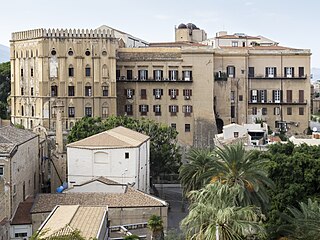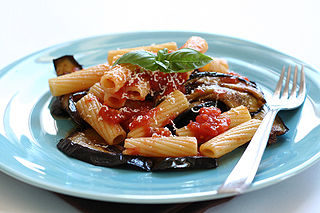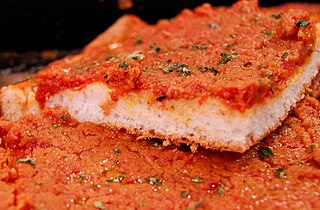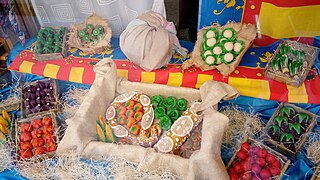
The almond is a species of tree from the genus Prunus cultivated worldwide for its seed, a culinary nut. Along with the peach, it is classified in the subgenus Amygdalus, distinguished from the other subgenera by corrugations on the shell (endocarp) surrounding the seed.

Palermo is a city in southern Italy, the capital of both the autonomous region of Sicily and the Metropolitan City of Palermo, the city's surrounding metropolitan province. The city is noted for its history, culture, architecture and gastronomy, playing an important role throughout much of its existence; it is over 2,700 years old. Palermo is in the northwest of the island of Sicily, by the Gulf of Palermo in the Tyrrhenian Sea.

Sicilian cuisine is the style of cooking on the island of Sicily. It shows traces of all cultures that have existed on the island of Sicily over the last two millennia. Although its cuisine has much in common with Italian cuisine, Sicilian food also has Greek, Spanish, French, Jewish, and Arab influences.

The Day of the Dead is a holiday traditionally celebrated on November 1 and 2, though other days, such as October 31 or November 6, may be included depending on the locality. It is widely observed in Mexico, where it largely developed, and is also observed in other places, especially by people of Mexican heritage. The observance falls during the Christian period of Allhallowtide. Some argue that there are Indigenous Mexican or ancient Aztec influences that account for the custom, and it has become a way to remember those forebears of Mexican culture. The Day of the Dead is largely seen as having a festive characteristic. The multi-day holiday involves family and friends gathering to pay respects and to remember friends and family members who have died. These celebrations can take a humorous tone, as celebrants remember funny events and anecdotes about the departed.

Marzipan is a confection consisting primarily of sugar and almond meal, sometimes augmented with almond oil or extract.

Cassata or cassata siciliana is a traditional cake from the Sicily region of Italy. Cassata is typically composed of a round sponge cake moistened with fruit juices or liqueur and layered with ricotta cheese and candied fruit. Cassata has a shell of marzipan, pink and green coloured icing, and decorative designs. Cassata may also refer to a Neapolitan ice cream containing candied or dried fruit and nuts.

Almond paste is made from ground almonds or almond meal and sugar in equal quantities, with small amounts of cooking oil, beaten eggs, heavy cream or corn syrup added as a binder. It is similar to marzipan, but has a coarser texture. Almond paste is used as a filling in pastries, but it can also be found in chocolates. In commercially manufactured almond paste, ground apricot or peach kernels are sometimes added to keep the cost down.

Sicilian pizza is a pizza prepared in a manner that originated in Sicily, Italy. Sicilian pizza is also known as sfincione or focaccia with toppings. This type of pizza became a popular dish in western Sicily by the mid-19th century and was the type of pizza usually consumed in Sicily until the 1860s. It eventually reached North America in a slightly altered form, with thicker crust and a rectangular shape.

The Church of St. Mary of the Admiral, also called Martorana, is the seat of the Parish of San Nicolò dei Greci, overlooking the Piazza Bellini, next to the Norman church of San Cataldo, and facing the Baroque church of Santa Caterina in Palermo, Sicily, southern Italy.

Caponata is a Sicilian dish consisting of chopped fried eggplant/aubergine and other vegetables, seasoned with olive oil, tomato sauce, celery, olives, and capers, in an agrodolce sauce.
Antonio Cottone was a member of the Sicilian Mafia in his hometown Villabate in the province of Palermo, Sicily. He was known as 'U Patre Nostru due to his alleged generosity. The Cottone clan was a historical Mafia family. They were mentioned in 1937 as the Mafia bosses of Villabate by Melchiorre Allegra, a mafioso physician who became an informant when he was arrested.

The Greco Mafia family is historically one of the most influential Mafia clans in Sicily, from the late 19th century. The extended family ruled both in Ciaculli and Croceverde Giardini, two south-eastern outskirts of Palermo in the citrus growing area. Members of the family were important figures in the Sicilian Cosa Nostra. Salvatore "Ciaschiteddu" Greco was the first ‘secretary’ of the Sicilian Mafia Commission, while Michele Greco, also known as The Pope, was one of his successors.

Princess cake is a traditional Swedish layer cake or torte consisting of alternating layers of airy sponge cake, pastry cream, and a thick-domed layer of whipped cream. The cake is covered by a layer of rolled marzipan, giving it a smooth, rounded top. The marzipan overlay is usually green, sprinkled with powdered sugar, and often decorated with a pink marzipan rose. While the original recipe did not contain any fruit, modern versions usually include layers of jam or fresh fruit, usually raspberries.

Vastedda is the traditional Sicilian bread used to prepare the pani câ meusa, a sandwich of veal spleen. It often also includes caciocavallo and ricotta toppings. Vastedda is most common in the city of Palermo.

Gioacchino Martorana was a Sicilian painter. He was the son of Pietro Martorana and a member of an extended family of decorators and artists from Palermo.
Pietro Martorana (1705–1759) was a Sicilian painter. He was the father of Gioacchino Martorana and a member of an extended family of decorators and artists from Palermo.

9 d'Octubre is a celebration in the Valencian Community. It commemorates the conquest of the city of Balansiyya by the troops of James I of Aragon and the creation of the Kingdom of Valencia in 1238.

Mocadorada, is a tradition from the Valencian Community celebrated each October 9, concurring with the National Day of Valencia. It consists of a collection of frutta martorana where the marzipan fruits are held inside of a handkerchief.
The Galatolo Mafia clan was a criminal family originating from the Acquasanta neighborhood of Palermo. They are one of the longest-running Mafia clans in the city, having held important positions throughout most of the 20th century and beyond and even coming to rule the entire Resuttana mandamento in the early 21st century.
















